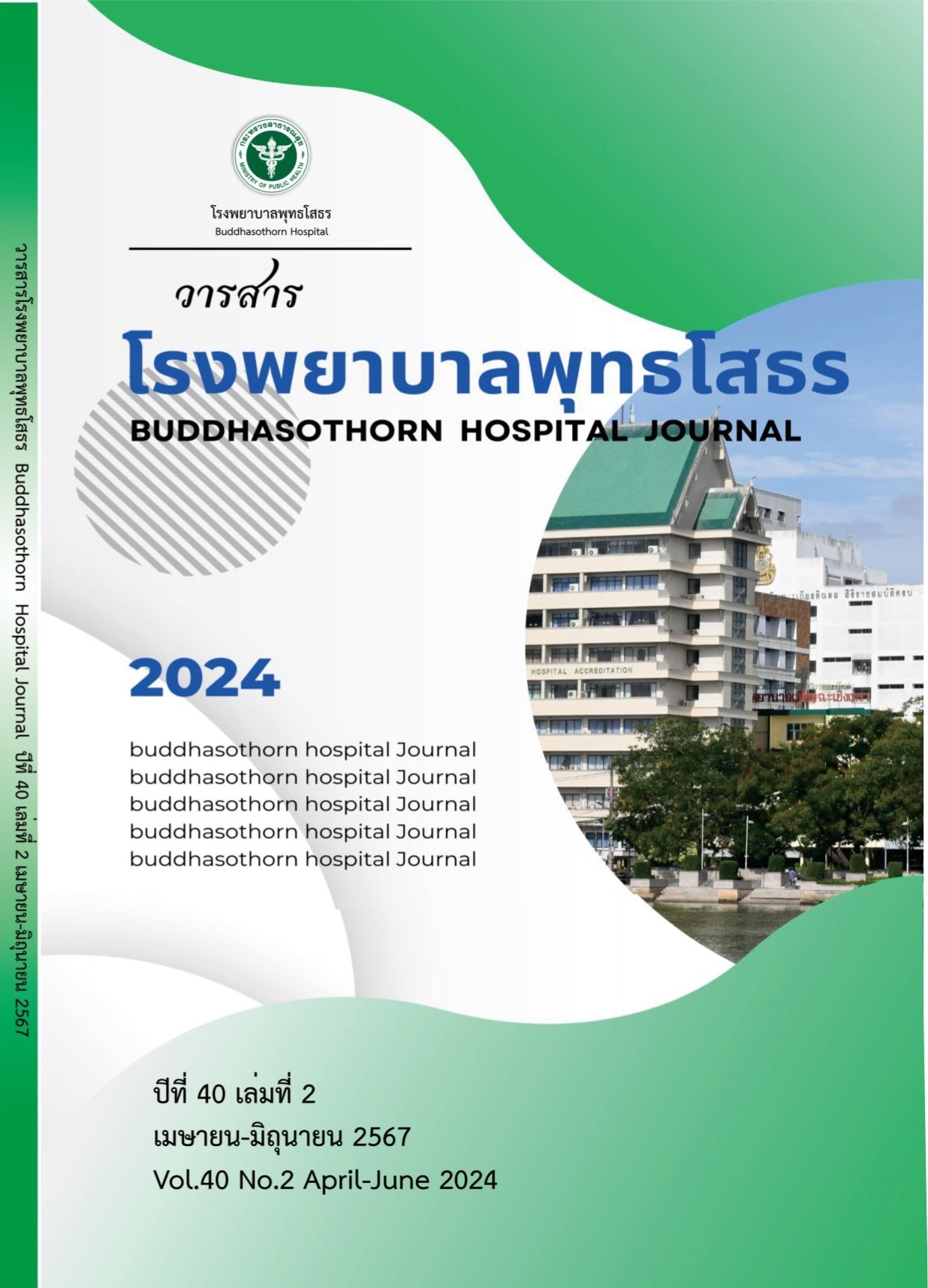การศึกษาภาวะแทรกซ้อนหลังการผ่าตัดส่องกล้องสลายนิ่วในท่อไตส่วนบน-กรวยไตเปรียบเทียบจากการใช้กล้องแบบแข็งและกล้องแบบโค้งในรพ.ระยอง
Main Article Content
บทคัดย่อ
ที่มาของปัญหา : โรคนิ่วในทางเดินปัสสาวะ พบอุบัติการณ์ทั่วโลกได้ประมาณ ร้อยละ 1-20 สาเหตุหลักเกิดจากความผิดปกติของการขับเกลือแร่ออกมาทางไต แนวทางที่เป็นมาตรฐานการรักษาปัจจุบันคือการส่องกล้องทางเดินปัสสาวะ เนื่องจากได้ผลการรักษาที่ดี ภาวะแทรกซ้อนต่ำ โดยเฉพาะนิ่วในท่อไต แต่หากพิจารณาแยกเป็นนิ่วในท่อไตส่วนบนและกรวยไต กลับมีรายงานการวิจัยไม่มากที่สามารถบ่งบอกได้ว่าการใช้กล้องแบบแข็งหรือแบบโค้งได้ผลการรักษาที่ดีกว่า มีภาวะแทรกซ้อนต่ำกว่า
วัตถุประสงค์ : เพื่อศึกษาภาวะแทรกซ้อนหลังการผ่าตัดส่องกล้องสลายนิ่วในท่อไตส่วนบน-กรวยไตเปรียบเทียบจากการใช้กล้องแบบแข็งและกล้องแบบโค้งในรพ.ระยอง
วิธีการศึกษา : ทำการเก็บข้อมูลการรักษานิ่วในทางเดินปัสสาวะในท่อไตส่วนบน กรวยไต โดยการส่องกล้องทางเดินปัสสาวะในโรงพยาบาลระยอง ใช้รูปแบบการวิจัยการศึกษาย้อนหลังเชิงพรรณนา (Retrospective Descriptive study) เก็บข้อมูลผู้ป่วยที่เข้ารับการรักษาระหว่างวันที่ 1 มกราคม 2561 ถึง 31ธันวาคม 2565 โดยสืบค้นข้อมูลย้อนหลังในระบบฐานข้อมูลของโรงพยาบาล และเก็บบันทึกข้อมูล โดยแบบบันทึกประกอบด้วย ข้อมูลทั่วไปของผู้ป่วย ข้อมูลลักษณะของนิ่ว ผลลัพธ์ ความสำเร็จ และภาวะแทรกซ้อนของการรักษา วิเคราะห์ข้อมูลด้วยสถิติเชิงพรรณนา ร้อยละ ค่าเฉลี่ย ส่วนเบี่ยงเบนมาตรฐาน ไคสแควร์และฟิชเชอร์แอกแซคเทส
ผลการศึกษา : ผลการศึกษา พบว่ามีผู้ป่วยทั้งหมด 61 คน เป็นเพศหญิง 30 คน(ร้อยละ 49.2) เพศชาย 31 คน(ร้อยละ 50.8) อายุเฉลี่ย 51.9 ปี ส่วนใหญ่มีโรคประจำตัวเป็นเมตาบอลิกซินโดรม(เบาหวาน ความดันโลหิตสูง ไขมันสูง เกาต์ โรคอ้วน)ร้อยละ 45.7 นิ่วที่พบมีขนาดนิ่วเฉลี่ย 16.2 ± 11.7 มิลลิเมตร โดยพบว่าอัตราความสำเร็จของการสลายนิ่วในท่อไตส่วนบน-กรวยไตด้วยกล้องแบบแข็งเท่ากับร้อยละ 63.3 และอัตราความสำเร็จของกล้องแบบโค้ง เท่ากับร้อยละ 67.7 โดยกล้องแบบโค้งมีอัตราความสำเร็จมากกว่ากล้องแบบแข็ง 3.49 เท่า การเกิดภาวะแทรกซ้อนทันทีโดยรวมทั้งหมดอยู่ที่ร้อยละ 4.9 และภาวะแทรกซ้อนโดยรวมที่เกิดภายหลังการผ่าตัดคือร้อยละ13.1 หากเปรียบเทียบภาวะแทรกซ้อนทันทีระหว่างการใช้กล้องแบบแข็งและแบบโค้งพบว่ามีอุบัติการณ์เกิดที่ร้อยละ 3.3 และ6.5 ส่วนภาวะแทรกซ้อนหลังผ่าตัดระหว่างการใช้กล้องแบบแข็งและแบบโค้งพบว่ามีอุบัติการณ์เกิดที่ร้อยละ 16.7 และ 9.7
สรุป : โดยสรุปผลการศึกษาพบว่าการรักษานิ่วโดยการส่องกล้องทางเดินปัสสาวะแบบแข็งและแบบโค้งเป็นหัตถการที่ปลอดภัย ได้ผลการรักษาที่ดี และมีภาวะแทรกซ้อนต่ำ
Article Details

อนุญาตภายใต้เงื่อนไข Creative Commons Attribution-NonCommercial-NoDerivatives 4.0 International License.
เอกสารอ้างอิง
Pak CY. Kidney stones. Lancet. 1998, 351(9118):1797-801
Ramello A, Vitale C, Marangella M. Epidemiology of nephrolithiasis. J Nephrol. 2000, 13 Suppl 3:S45-50.
Sriboonlue P, Prasongwattana V, Tungsanga K, Tosukhowong P, Phantumvanit P, Bejraputra O,et al. (1991). Blood and urinary aggregator and inhibitor composition in controls and renal-stone patients from northeastern Thailand. Nephron, 59, 591–596.
Stamatelou K, Goldfarb DS. Epidemiology of Kidney Stones. Healthcare (Basel). 2023, 11(3):424.
EAU Guidelines. Edn. presented at the EAU Annual Congress Milan 2023. ISBN 978-94-92671-19-6.
Güler Y, Erbin A. Comparative evaluation of retrograde intrarenal surgery, antegrade ureterorenoscopy and laparoscopic ureterolithotomy in the treatment of impacted proximal ureteral stones larger than 1.5 cm. Cent European J Urol. 2021;74(1):57-63.
Knoll T, Alken P. Rückblick auf 50 Jahre Steintherapie [Looking back on 50 years of stone treatment]. Aktuelle Urol. 2019, 50(2):157-165. German.
Berardinelli F, Proietti S, Cindolo L, Pellegrini F, Peschechera R, Derek H, et al. (2016). A prospectivemulticenter European study on flexible ureterorenoscopy for the management of renalstone. Int Braz J Urol, 42(3), 479-486.
Nualyong C, Sathidmangkang S, Woranisarakul V, Taweemonkongsap T, Chotikawanich E. (2019). Comparison of the outcomes for retrograde intrarenal surgery (RIRS) and percutaneousnephrolithotomy (PCNL) in the treatment of renal stones more than 2 centimeters.TJU, 40(1), 9-14.
Chung KJ, Kim JH, Min GE, Park HK, Li S, Del Giudice F, Han DH, Chung BI. Changing Trends in the Treatment of Nephrolithiasis in the Real World. J Endourol. 2019, 33(3):248-253.
Wymer KM, Sharma V, Juvet T, Klett DE, Borah BJ, Koo K, Rivera M, Agarwal D, Humphreys MR, Potretzke AM. Cost-effectiveness of Retrograde Intrarenal Surgery, Standard and Mini Percutaneous Nephrolithotomy, and Shock Wave Lithotripsy for the Management of 1-2cm Renal Stones. Urology. 2021, 156:71-77.
Assimos D, Krambeck A, Miller NL et al: Surgical management of stones: American Urological Association/Endourological Society Guideline, part II. J Urol 2016; 196: 1161.
Wu CF, Shee JJ, Lin WY, Lin CL, Chen CS. Comparison between extracorporeal shock wave lithotripsy and semirigid ureterorenoscope with holmium:YAG laser lithotripsy for treating large proximal ureteral stones. J Urol. 2004, 172(5 Pt 1):1899-902.
Jung HD, Hong Y, Lee JY, Lee SH. A Systematic Review on Comparative Analyses between Ureteroscopic Lithotripsy and Shock-Wave Lithotripsy for Ureter Stone According to Stone Size. Medicina (Kaunas). 2021, 57(12):1369.
Chung DY, Kang DH, Cho KS, Jeong WS, Jung HD, Kwon JK, Lee SH, Lee JY. Comparison of stone-free rates following shock wave lithotripsy, percutaneous nephrolithotomy, and retrograde intrarenal surgery for treatment of renal stones: A systematic review and network meta-analysis. PLoS One. 2019, 14(2):e0211316.
Kijvikai K, Haleblian GE, Preminger GM, de la Rosette J. Shock wave lithotripsy or ureteroscopy for the management of proximal ureteral calculi: an old discussion revisited. J Urol. 2007, 178(4 Pt 1):1157-63.
Kartal I, Baylan B, Çakıcı MÇ, Sarı S, Selmi V, Ozdemir H, Yalçınkaya F. Comparison of semirigid ureteroscopy, flexible ureteroscopy, and shock wave lithotripsy for initial treatment of 11-20 mm proximal ureteral stones. Arch Ital Urol Androl. 2020, 92(1):39-44.
Liu DY, He H, Wang J, et al. Ureteroscopic lithotripsy using holmium laser for 187 patients with proximal ureteral stones. Chin Med J. 2012; 125:1542-6.
Somani BK, Giusti G, Sun Y, Osther PJ, Frank M, De Sio M, Turna B, de la Rosette J. Complications associated with ureterorenoscopy (URS) related to treatment of urolithiasis: the Clinical Research Office of Endourological Society URS
Galal EM, Anwar AZ, El-Bab TK, Abdelhamid AM. Retrospective comparative study of rigid and flexible ureteroscopy for treatment of proximal ureteral stones. Int Braz J Urol. 2016, 42(5):967-972.
Hong YK, Park DS. Ureteroscopic lithotripsy using Swiss Lithoclast for treatment of ureteral calculi: 12-years experience. J Korean Med Sci. 2009; 24:690–694.

